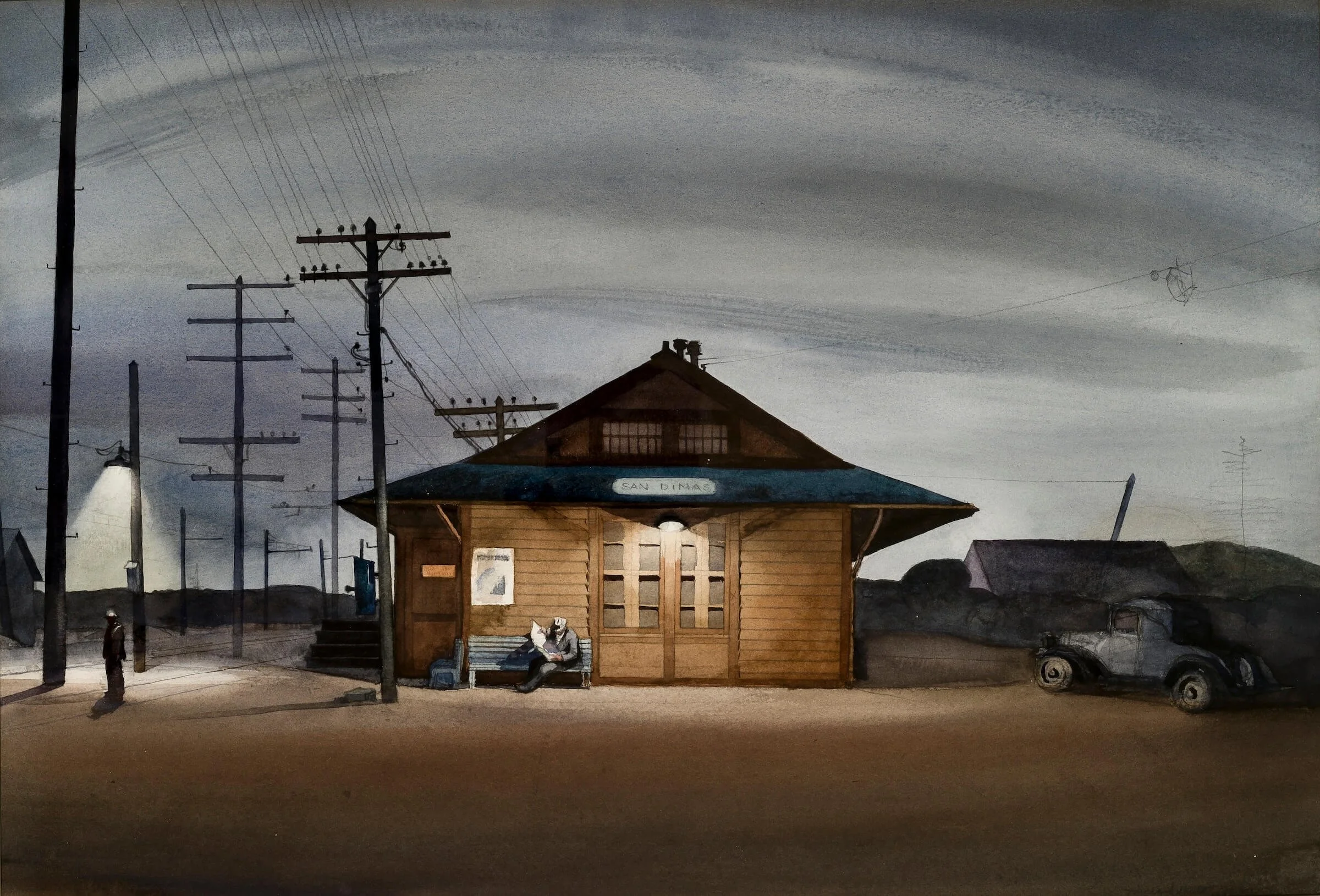Book Excerpt, Mark and Jan Hilbert: The Love Story that Launched an Art Museum
The following introduction is an excerpt from Liz Goldner's forthcoming book, Mark and Jan Hilbert: The Love Story that Launched an Art Museum.
Introduction
Art lovers might ask, why are museums founded? While the motivations behind the origins of these cultural venues vary, the stories of their formations are often legendary. Yet few museums have stories that are as heartwarming as that of the Hilbert Museum of California Art at Chapman University in Orange.
As museum co-founder/donor Mark Hilbert tells it, in 2012, he was touring a major museum. "I went to one gallery and was very disappointed by the exhibition there with its strong political overtones," he says. "I went to the next gallery and was even more upset by the dark display. I immediately left the museum and drove home. On my way, I kept thinking that my beloved wife Janet and I, with our expansive and diverse collection of California art, could create a museum that would be much more interesting for people to visit, that would bring viewers to sanity, that is upbeat, inspiring and family friendly."
Motivated by the story-telling and aesthetic aspects of California artworks, the Hilberts — with the advice of art historians and gallerists, with their study of art history and extensive viewing of art exhibitions in this country and abroad — had already acquired several thousand pieces of more than a century of California art.
The Hilbert Collection also includes still lifes, landscapes, animation cels from Hollywood studios, concept paintings and sketches. The comprehensive collection, encompassing California's unique and expansive spirit, takes visitors on a tour of the state's idyllic settings over many decades. The collection also includes artworks from other areas, including 20th-century American illustrations, Native American blankets, pottery, and the classic mid-20th-century radios that Mark began collecting in the 1980s, and more.
Gordon McClelland, art historian and curator of several Hilbert Museum exhibitions, wrote, "Art can serve as a window to the past. This is particularly true when referring to paintings where the artist chose to visually tell a story." Mark adds, "There are so many gems of storytelling in California Scene Paintings. These artworks, often referred to as genre paintings, were inspired by American Scene Paintings, also known as Regionalism, by artists including Thomas Hart Benton, Grant Wood, Edward Hopper and John Steuart Curry." California Scene Paintings were also influenced by the early 20th century Ash Can School, an art movement portraying people, homes, restaurants, movie houses and other elements of New York City life by artists including Robert Henri, Everett Shinn and George Bellows.
The inimitable Hilbert Collection, along with Mark's impactful 2012 museum visit, encouraged the Hilberts to move forward founding their own art museum. Their objective was to exhibit the many thousands of paintings they had already acquired. "With our diversified art collection, we had created the opportunity to present an endless variety of thematic exhibitions," Mark says. "We also recognized that California Scene Painting was a largely overlooked but very important art movement, and that the artists who did this work had never been acknowledged as a group. We wanted to remedy that omission."
Four years later, in 2016, the Hilbert Museum of California Art opened to great acclaim from visitors, students, the press and Chapman University. The narrative art on display afforded viewers many heartwarming scenes of the Golden State over the decades. Duncan Phillips, founder of Washington D.C.'s Phillips Collection, believed, "art is a source of solace, a link to wellness, and an essential positive force in society."
Life Affirming Story
Mark and Janet Hilbert's journey is a life-affirming story of their love for California art, of their desire to contribute to their community by exhibiting the finest examples of this artwork, and of their love and admiration for each other. While art aficionados and collectors have long admired California Scene Paintings, the Hilberts have facilitated the definition and advancement of this art movement by creating the free-to-the-public Hilbert Museum of California Art. "This is the only museum in the country to exhibit this this type of artwork extensively," Mark explains.
As a couple who met in their forties in 1991, Mark and Janet came to embrace their relationship with each other, with their extended family and with their many friends and colleagues throughout the California art world and beyond. They soon became missionaries for the California narrative art style, which serves as a window into the state's illustrious history. McClelland explains that Mark and Jan have a natural gift of intuitive discernment when it comes to selecting art.
In 1993, Mark and Janet put together enough money to purchase a vacation house in Palm Springs. As the economy was in a slump, and with little money to furnish their home, "we began our journey hunting through garage sales and antique stores," Jan explained, "looking for items that caught our eye, and then of course we needed paintings to cover the walls." They bought their first California watercolor in a consignment shop; the painting became part of the foundation of the Hilbert Museum. "As Jan and I had grown up in California," Mark says, "we immediately related to that landscape, and soon learned that many California artists had painted on location in the outdoors, giving the art pieces spontaneity and in-the-moment realism." After reading the book The California Style: Watercolor Artists 1925-1955 by McClelland and Jay T. Last, the Hilberts decided to focus on California Scene Paintings for many future acquisitions.
As the economy improved, they ramped up their art collecting and acquired more paintings. One day, Jan looked at their growing art collection and commented, "I'd like to see people in the paintings, as they are more interesting that way and they tell stories. Paintings with people are easier for visitors to look at and relate to." The couple began purchasing more narrative style artworks in the 2000s. Many of their paintings are exhibited today in the Hilbert Museum and in their home, and have been on loan to major museums including the Getty Museum, the Los Angeles County Museum of Art and the Autrey Museum, all in Los Angeles, the California Heritage Museum in Santa Monica, and the Crystal Bridges Museum of American Art in Bentonville, Arkansas.
A visit to the Hilberts' home reveals art pieces and furnishings displayed in every room and hallway. The backdrop for their collection is their Italian-style house with high ceilings, cream-colored walls and Spanish style furnishings. Two of their favorite art objects are varguenos, desks that tax collectors used. A large wooden desk is from 17th century Spain. A smaller silver desk is from 18th century Peru. "Growing up in the Pasadena area, I had friends who lived in homes with Spanish style architecture and furnishings, and I came to love that style," Mark explains.
Complementing the Hilberts' dramatic furnishings are their many California Scene Paintings, skillfully juxtaposed among the Navajo earthenware jars that Mark began acquiring in New Mexico in the 1980s. One favorite painting is Millard Sheets' San Dimas Train Station (1933). This nostalgic watercolor, one of the first important paintings that the Hilberts acquired, depicts a lonely 19th century wooden train depot, with a seated man reading a newspaper and a second man standing near the rails beneath a beam of light. "The painting evokes a variety of feelings, including isolation and calmness," Mark explains. Another favorite is Fletcher Martin's Bucolic (1938), illustrating a woman seated on the ground, wearing a thoughtful, confident expression and draped clothing, muted in color. The man relaxing next to her is dressed similarly, while his broad-brimmed hat partially shades his face. The surroundings are pastoral, with the painting evoking Mexican muralism in its style, along with peace and harmony. Both artworks, exemplifying the distinctive scene painting style, draw viewers to them with their storytelling aspects.
As Mark and Jan Hilbert: The Love Story that Launched an Art Museum progresses, I describe the Hilberts' journey of discovery of their passion for fine art through extensive visits to European museums and personal study. I write about the history of California art, including the evolution of genre art into California Scene Painting, the themes, styles, and influences of scene paintings, and the museum's original 2014 opening and 2016 expansion.
I quote from the 1914 book "Nationality in Pictures" by Duncan Phillips, founder of The Phillips Collection, Washington, D.C. who noted, "Not only does America inherit the arts of all nations and of all ages, but rich should be the harvesting and exquisite the flowering of the strong, sound and aspiring American spirit from the seeds of aesthetic purpose, now so wisely and so bountifully being sown in her own native soil."
Ultimately, I conclude the book with the following statement: The museum in its entirety acknowledges its many artists' profound contributions to American culture. It also reveals how the founders' aspirations and personalities are displayed in every gallery. Visiting the Hilbert Museum of California Art amounts to taking an illuminating tour through 150 years of California art, while viewing numerous insightful scenes of the Golden State.








